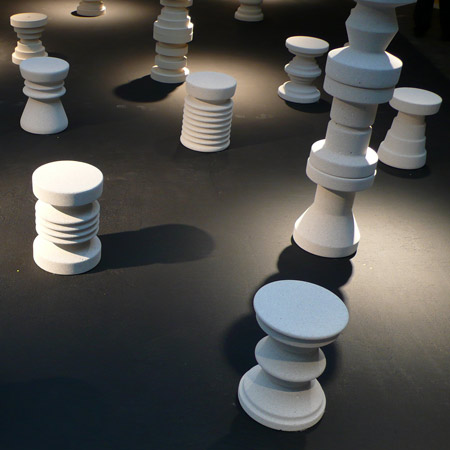Design Miami/Basel 08: Max Lamb was one of four Designers of the Future at last week's Design Miami/Basel, showing a series of turned stools.
As well as Julia Lohmann, Martino Gamper and Kram/Weisshar, Lamb designed and exhibited a body of work using wool and concrete. See Lohmann's project, Resilience, in our earlier story.
Lamb's project involved turning stools from concrete (above) and laminated felt disks (below).
See our earlier story for more details of all this year’s Designers of the Future.
Here's some text from Max Lamb:
--
Max Lamb
Designer of the Future
Design Miami/Basel 2008
Solids of Revolution
Concrete and Felt Stools.
Solids of Revolution are two collections of stools in concrete and wool felt formed using rotational cutting processes. Two inherently disparate materials unified by property and by process.
Hard, heavy concrete becomes lightweight and malleable. Soft, supple wool becomes rigid and strong. The convergence of two polar opposites at a state of physical property where the same processes apply.
Both collections are made from preformed objects designed for industrial applications, offering primary function to otherwise secondary articles. The humble concrete block used to build family dwellings and architectural monoliths, and discs of pressed wool felt that are mounted onto a rotational spindle for use in the metal, glass and stone polishing industry.
Solid of Revolution describes a solid object obtained by rotating a plane profile around an axis, an expression that simulates both the process of turning on a lathe and the rotational aspect of a felt polishing disc.
Concrete Stools
Autoclaved Cellular Concrete is a foamed concrete containing a high volume of air in a cell-like structure. The material is five times lighter than concrete, highly insulating and easily machined making it perfect for turning on a lathe.
Concrete Stools are turned from a complete palette of 18 autoclaved cellular concrete blocks 32 x 32 x 62cm in size. These blocks present perfect dimensions for a seat surface and sitting height and can be mounted onto a lathe and formed using traditional wood-turning tools. Every stool is unique and none were predetermined. Each stool a consequence of that preceding it.
Felt Stools
When wet wool fibres are repeatedly rubbed together under pressure the tiny scales on each fibre naturally stitch together and become matted. If the process is continued and compression increased it is possible to create a block of natural textile that displays similar properties to wood, thus capable of being machined.

